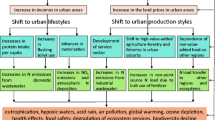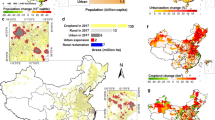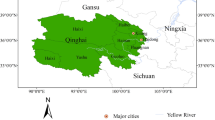Abstract
Urban nitrogen discharge has become an important factor leading to urban water environment deterioration, water crisis, and frequent air pollution. Human consumption is the driving force of nitrogen flow and the core of urban nitrogen research. Based on the process of nitrogen flow in the urban human system, combined with the relevant United Nations Sustainable Development Goals (SDGs) and taking Dar es Salaam as an example, we established a generic analytical framework for sustainable nitrogen management and put forward the strategies of sustainable nitrogen management in the urban human system. The main conclusions are as follows. (1) Waste nitrogen discharge affected the environment quality. 5286 t of N (5095 t of N-NH3, 86 t of N-N2O, and 105 t of N-NOx) was emitted into the atmosphere that affected air quality. 9304 t of N was discharged into surface water and 203 t of N was leaked, which had a negative impact on the prevention and control of surface water pollution. And 8334 t of N pose a potential threat to environmental quality. (2) Nitrogen management in Dar es Salaam faced huge challenges. From the perspective of nitrogen flow of the urban human system, the diet structure and household energy structure need to be optimized, and food waste is serious. Sewage treatment and garbage treatment are seriously insufficient, and the corresponding technologies are backward. In order to solve the existing problems of nitrogen flow in the urban human system and include sustainable nitrogen management under future challenges of growing population and economy, we proposed strategies including healthy diet guidance, reducing food waste, detailed assessment of household nitrogen accumulation, transformation of household energy structure to low nitrogen emission energy, increasing nitrogen recycling ratio, and infrastructure improvement of sewage treatment and garbage treatment, hence contributing to the achievement of related SDGs.





Similar content being viewed by others
Data availability
Not applicable.
References
Barles S (2010) Society, energy and materials: the contribution of urban metabolism studies to sustainable urban development issues. J Environ Planning Manage 53(4):439–455
Clark MA, Domingo NGG, Colgan K, Thakrar SK, Tilman D, Lynch J et al (2020) Global food system emissions could preclude achieving the 1.5 and 2°Cclimate change targets. Science 370:705–708
Dong Y, Xu L, Yang Z, Zheng H, Chen L (2020) Aggravation of reactive nitrogen flow driven by human production and consumption in Guangzhou City China. Nat Commun 11:1209
Erisman JW, Galloway JN, Seitzinger S et al (2013) Consequences of human modification of the global nitrogen cycle. Philos Trans R Soc B 368:20130116
Faerge J, Magid J, Vries F (2001) Urban nutrient balance for Bangkok. Ecol Model 139(1):63–74
FAO (2011) FAOSTAT: FAO statistical database. Italy, Rome
Fissore C, Baker LA, Hobbie SE, King JY, Mcfadden JP, Nelson KC et al (2011) Carbon, nitrogen, and phosphorus fluxes in household ecosystems in the minneapolis-saint paul, minnesota, urban region. Ecol Appl 21(3):619–639
Forkes J (2007) Nitrogen balance for the urban food metabolism of Toronto, Canada. Resour Conserv Recycl 52(1):74–94
Galloway JN, Townsend AR, Erisman JW et al (2008) Transformation of the nitrogen cycle: recent trends, questions, and potential solutions. Science 320:889–892
Gao B, Huang Y, Huang W, Shi Y, Cui S (2018) Driving forces and impacts of food system nitrogen flows in china, 1990 to 2012. Sci Total Environ 610–611:430–441
Gruber N, Galloway J (2008) An Earth-system perspective of the global nitrogen cycle. Nature 451:293–296
Gu B (2011) Nitrogen cycles of coupled human and natural system -a case study of China. Zhejiang University, Hangzhou ((In Chinese))
Hu FB, Willett WC (2002) Optimal diets for prevention of coronary heart disease. JAMA 288(20):2569–2578
Jiang S, Hua H, Sheng H et al (2019) Phosphorus footprint in china over the 1961–2050 period: historical perspective and future prospect. Sci Total Environ 650:687–695
Mapunda DW, Chen SS, Yu C (2018) The role of informal small-scale water supply system in resolving drinking water shortages in peri-urban Dar Es Salaam, Tanzania. Appl Geogr 92:112–122
NBS (2018) National Environment Statistics Report, 2017 (NESR, 2017). Dar es Salaam, Tanzania
NIGLAS & TAFIRI (2017) Water quality investigation in major cities of Tanzania [Report], Dar es Salaam, Tanzania.
Nino FS (2015) Sustainable development goals—United Nations
Piao S, Fang J, Ciais P et al (2009) The carbon balance of terrestrial ecosystems in China. Nature 458:1009–1013
Prud’homme M (2017) Global fertilizers and raw materials supply and supply/demand balances 2017–2021. Marrakech: International Fertilizer Industry Association.
Rand WM, Pellett PL, Young VR (2003) Meta-analysis of nitrogen balance studies for estimating protein requirments in healthy adults. Am J Clin Nutr 77:109–127
Schlesinger WH (2009) On the fate of anthropogenic nitrogen. PNAS 106:203–208
Shi Y, Yamaguchi Y (2014) A high-resolution and multi-year emissions inventory for biomass burning in Southeast Asia during 2001–2010. Atmos Environ 98:8–16
Sutton MA, Bleeker A (2013) Environmental science: the shape of nitrogen to come. Nature 494(7438):435
UN-HABITAT (2010) Informal settlements and finance in Dar es Salaam, Tanzania [Report]. Nairobi, Kenya
Wolf AZ, Patz JA (2002) Reactive nitrogen and human health: acute and long-term implications. Ambio 31:120–125
Xiong C, Guo Z, Chen SS, Gao Q, Kish MA, Shen Q (2020) Understanding the pathway of phosphorus metabolism in urban household consumption system: a case study of Dar es Salaam Tanzania. J Cleaner Production 274:122874
Xiong C, Xu L, Mhagama FL, Chen SS, Zhu KX, Gao Q, Li H, Su W (2023) Reactive nitrogen budgets in human-nature coupling system in lakeside area with insufficient data- a case study of Mwanza, Tanzania. Science of the Total Environment, 158915.
Acknowledgements
I am very grateful to the editors and anonymous reviewers for reviewing this paper.
Funding
This work was supported by the National Key R&D Program of China (No. 2018YFE0105900) and the National Natural Sciences Foundation of China (42001133).
Author information
Authors and Affiliations
Contributions
Chuanhe Xiong: data curation, methodology, writing—original draft, validation. Zheng Guo: visualization. Sophia Shuang Chen: writing—reviewing and editing. Qun Gao: supervision. Ismael Aaron Kimirei: investigation. Hengpeng Li: writing—reviewing and editing. Weizhong Su: writing—reviewing and editing.
Corresponding author
Ethics declarations
Ethics approval
Not applicable.
Consent to participate
Not applicable.
Consent for publication
Not applicable.
Competing interests
The authors declare no competing interests.
Additional information
Responsible Editor: Baojing Gu
Publisher's note
Springer Nature remains neutral with regard to jurisdictional claims in published maps and institutional affiliations.
Supplementary Information
Supplementary file 1: Table S1
. Consumption of main daily necessities in Dar es Salaam. Table S2. Household waste and waste water treatment in Dar es Salaam. Table S3. Nitrogen concentrations of main daily necessities. Table S4. Emission coefficients of household fuel (Unit: g/kg). Table S5. Directions of the nitrogen flow of human metabolism (Unit: %). Table S6. Destination ratio of nitrogen in urban feces and urine (Unit: %). Table S7. Equation of calculating N. Questionnaire S1. Dar es Salaam Residents' Living Consumption Questionnaire.
Rights and permissions
Springer Nature or its licensor (e.g. a society or other partner) holds exclusive rights to this article under a publishing agreement with the author(s) or other rightsholder(s); author self-archiving of the accepted manuscript version of this article is solely governed by the terms of such publishing agreement and applicable law.
About this article
Cite this article
Xiong, C., Guo, Z., Chen, S.S. et al. Sustainable nitrogen management strategies based on nitrogen flow in urban human system. Environ Sci Pollut Res 30, 52410–52420 (2023). https://doi.org/10.1007/s11356-023-26047-9
Received:
Accepted:
Published:
Issue Date:
DOI: https://doi.org/10.1007/s11356-023-26047-9




